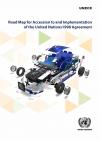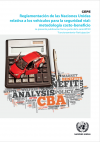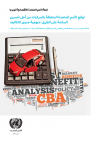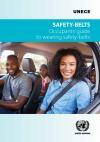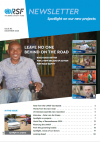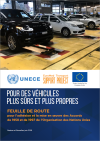Publications
Displaying Results 21 - 40 of 66
- English
The implementation of vehicle regulations related activities demonstrated that, through accession to and implementation of the 1998 Agreement, vehicles safety will be increased considerably. However, the main issue for many countries remains how to prepare for accession and implementation of this Agreement so that they can benefit from its provisions, ensuring that safer and less polluting
- English
In April 2020, a UN Task Force was set up to develop recommendations for green and healthy sustainable transport to assist member States in the post COVID-19 recovery. Bringing together over 50 experts from member States, international institutions, academia, public transport operators and industry experts, the Task Force set up under the Transport, Health and Environment Pan-European Programme
- Español
En la presente publicación, que forma parte de la serie WP.29, “FuncionamientoParticipación”, se muestran las metodologías que se utilizan para evaluar la rentabilidad socioeconómica de la aplicación de las principales normas de las Naciones Unidas relativas a los vehículos para mejorar la seguridad vial. Se presenta una visión general actual de la seguridad vial y de las estadísticas de
- English
Part of the WP.29, “How it works – How to join it” series, this publication introduces methodologies that are used to evaluate the socioeconomic utility of applying key UN Vehicle Regulations for improving road safety. It presents an overview of current global road safety and vehicle safety statistics, describes methodologies that are used for assessing the impact of vehicle regulations on
- العربية
هذا المنشور جزء من سلسلة المنتدى العالمي لتنسيق اللوائح المتعلقة بالمركبات
"كيف يعمل وكيف تنضم إليه"، وهو يعرض المنهجيات المستخدمة في تقييم المنافع الاجتماعية
والاقتصادية التي يحققها تطبيق لوائح الأمم المتحدة الرئيسية المتعلقة بالمركبات من أجل تحسين
السامة على الطرق. وهو يتضمن نظرةً عامةً عن إحصاءات السامة على الطرق وسامة المركبات
في العالم حاليا،ً ويصف المنهجيات المستخدمة في تقييم تأثير لوائح
- English
The benefits of buckling up safety-belts are clear. If you buckle up in the front seat of a passenger car you can reduce your risk of a fatal injury by 45% (Kahane, 2015) and moderate to critical injury by 50%. Fastening safety-belts helps you to stay in control of your vehicle during when the unexpected occurs such as an abrupt deceleration.
This leaflet is designed to provide basic information
- English
While the second half of 2020 was marked by the warranted fight against the COVID-19 pandemic which continued to change the face of the world, our ambitions for a better global road safety were not scaled back. COVID-19 has taught us to move away from the “silo mentality” and instead align development goals with each other - resulting in higher impact policies and programs.
- English
The UN Road Safety Fund was established in 2018 as a UN multi-partner trust fund pursuant to the General Assembly resolution 70/260 and with the support of the UN Secretary-General. It aims to help low- and middle-income countries put in place an effective national Safety System to substantially
- English
Updated Guidelines on the use of the UNRSF brand and logo
- Pусский
Услуги совместной мобильности являются частью экономики совместного пользования, в основе которой лежит идея рационального использования ограниченных ресурсов, создающая для человека возможность позволить себе качественные товары и услуги по разумной цене.
В настоящей работе представлена краткая история возникновения и развития сервисов совместной мобильности, которые способствуют более
- English
Shared mobility services are the part of the shared economy, which is based on the idea of rational use of limited resources, which creates an opportunity for a person to afford highquality goods and services at a reasonable price.This study provides a brief history of the emergence and development of shared mobility services, which contribute to a more efficient use of available resources
- English
The UNRSF launches the second issue of its newsletter at a time when the world continues to face unprecedented change and disruptions due to the Covid-19 pandemic. However, the momentum gained with the 3rd Global Ministerial Conference on Road Safety in February 2020 where the Stockholm Declaration was launched with an ambitious target to reduce road deaths and injuries by 50% by 2030 must not
- English
The UN Road Safety Fund’s (UNRSF) secretariat seeks additional financial support from private and public sector donors where the Fund’s mission and donor priorities are aligned. Read more in the UNRSF donor brochure to consider becoming a donor.
Contact the UNRSF secretariat for more information at unrsf_secretariat
- English
The UNRSF 2019 Annual Report is now available. Established two years ago as an innovative United Nations pooled fund, the Annual Report showcases the first concrete results of the UNRSF and thus demonstrates its potential to meet its ambition to substantially reduce death and injuries from road crashes in low and middle-income countries where 93% of the world fatalities occur.
- English
Organizations around the world are quickly adapting their programme and project activities to respond to the COVID-19 pandemic and its consequences. The UN Road Safety Fund is committed to the principles of adaptive programming, partnerships, and relevance. The operationalization of these principles is even more critical during this unparalleled time. This flyer provides tools and tips for
- English
This study, commissioned by the Steering Committee of the Transport, Health and Environment PanEuropean Programme (THE PEP) through its Partnership on Jobs in Green and Healthy Transport, examines the economy-wide employment implications of an accelerated shift towards greener land
- English
The April 2020 marks the second anniversary of the launch of the United Nations Road Safety Fund (UNRSF). The Fund is now financing 15 projects in 20 low- and middle-income countries to substantially reduce death and injuries from road crashes and to reduce economic losses resulting from these crashes.
- Français
Le nombre d’accidents de la route reste inacceptablement élevé et représente l’une des principales causes de décès et de blessures dans le monde, faisant plus de 1,3 million de morts et 50 millions de blessés par an, dont 90 % dans les pays en dé-veloppement. Tous les pays et toutes les régions du monde mettent en œuvre des mesures pour y remédier. Il convient de mentionner que le Plan mondial


